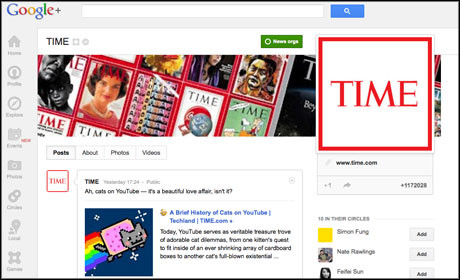
Time magazine has clocked up 1.17 million followers on Google+, the social network which launched a year ago today.
Time has a notable social media following, achieving the status of "number three news brand on Twitter" with over 3.6 million followers, it has 541,000 fans on its Facebook page and an impressive 35,000 followers on Foursquare.
While many news organisations have found little success on Google+, Time and also the Financial Times have both clocked up more than one million followers.
So how did Time reach that figure?
1. Join social networks early
Cathy Sharick, managing editor of Time.com told Journalism.co.uk she thinks it helped that they were early adopters, joining Google+ as it made brand pages available in November.
Joining a new platform early is "very helpful in establishing a following on the social networks," Sharick said. Time has also recently joined Stamped, a review network for iPhone which launched late last year.
2. Get to know your audience
Sharick said that another reason for its success is because Time knows its Google+ audience well.
"We are posting content that we know resonates with the readers. It is tech content, that is something that we know that the readership likes, but we also know that people are looking at our in-depth coverage and enterprise stories."
One Time magazine cover story that "sparked a lot of conversations" on Google+ and other networks was the breastfeeding cover, with a picture of a 26-year-old mother breastfeeding a three-year-old standing on a chair.

3. Add a G+ button
Time.com has also integrated the Google+ button so each news story can be shared easily and that has "really helped in a big way", Sharick said.
4. Connections help search
Has Google+ become a notable traffic driver for Time? "We definitely have seen that the personalised search results from Google have helped us," Sharick said.
When a person adds a news organisation's branded page to their Google+ circles, they see stories from that provider are ranked higher in Google search engine results.
"That is driving the traffic" for Time, Sharick said.
5. Encourage comments
Time has found its followers on Google+ to be "very talkative", writing "very well thought out comments".
"We definitely see that on our other platforms as well but even more so on Google+."
6. Get to know your audience
Sharick advises those managing a news site's Google+ page to get to know the audience and ask them questions.
7. Sort your circles
She also suggests social media managers "set up circles that correspond to your beat". "That really helps as the more you target your circles, the more your stories will engage with the audience."
For more on sorting your circles see our 10 tips for journalists using Google+ published a week after the launch of the network..
8. Hangout with your audience
Time.com has also been using the Google+ Hangout video feature. Last week they did a Google+ Hangout On Air with the "We Are Americans" cover story on what it means to be an "undocumented immigrant".
They have held another hangout on the subject of video game violence.
"Both have been popular and well received," Sharick said. Last week's hangout was with a "very engaging cover subject and we were able to bring the people participating to life and really personalise the story on the hangout".
Viewers were able to "see where these people were living, and really get involved in what their stories were and see them on the screen as they were talking with our social media editor".
And Time is planning more hangouts. "We are looking at different cover stories that are coming out," Sharick said.
The team is also thinking of creative ways to discuss Time's 100 lists, such as the top iPhone apps and best websites, and is "also looking at elections panels and the Olympics," Sharick added.
Free daily newsletter
If you like our news and feature articles, you can sign up to receive our free daily (Mon-Fri) email newsletter (mobile friendly).
Related articles
- Finding Home: TIME's year-long multimedia project about the lives of refugee mothers
- TIME starts year-long multimedia project documenting the lives of Syrian refugee mothers and their babies
- 10 lessons as BBC News hits social media milestones
- 10 social media engagement tips from the Financial Times
- #Tip: Keep an eye out for the launch of Google Capture for Hangouts











